The McDonald's Happy Meal celebrates 40th anniversary
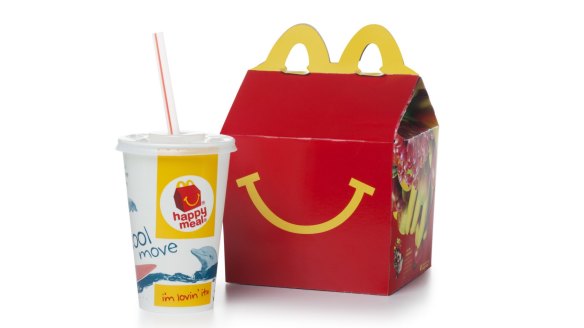
CHICAGO: The American summer of 2019 is a summer of monumental anniversaries: the 50th anniversary of the first moon landing, the 50th anniversary of Woodstock and the 30th anniversary of the fall of the Berlin Wall.
But how do we think about the 40th anniversary of the McDonald's Happy Meal?
Monumental? Game-changing? Cynical?
All of the above?
The object itself is ephemeral. Just cardboard and plastic and some loose french fries. There will be no CNN documentaries or coffee-table books that explore the meaning of the Happy Meal. And yet, possibly, the Happy Meal has played a larger part in your everyday life than the space race, a music festival in upstate New York or the decline of Soviet communism.
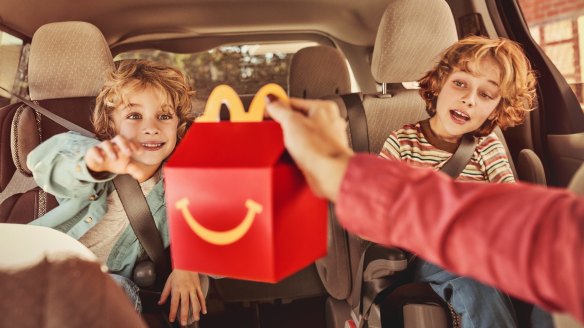
A happy milestone?
I thought, we [could] make a box for McDonald's that holds a meal and gives kids things to do.Bob Bernstein
We could celebrate Happy Meals.
The past decade has seen McDonald's introduce leaner versions, with apple slices and fewer fries per box. There's also a collector's market for Happy Meal toys, reminding us of the value of nostalgia. Meanwhile, tucked inside that nostalgia, we also see a cultural artefact that, for many children offered a first bit of autonomy, their own food.
In a statement, McDonald's global chief marketing officer, Silvia Lagnado, said, "Thanks to the Happy Meal, most adults associate McDonald's with special childhood memories."
Or unhealthy millstone?
We could also bemoan Happy Meals.
In the late 1970s, it helped to cement the parameters of what was permissible when fast-food restaurants marketed to children. Later, it became Exhibit A for nutritionists eager to identify the causes of childhood obesity; indeed, the healthier Happy Meals of today are a response to the criticisms of the Happy Meal from the early 1980s. You might even say the Happy Meal – along with play dates, the end of free-range children and instructions for Lego – was one more small step to formatting childhood.
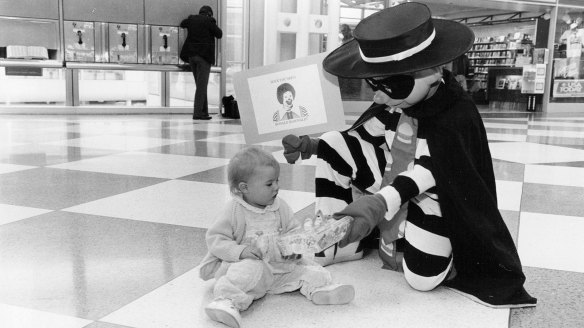
Fuzzy beginnings
But there's an even larger existential question here: who created the Happy Meal?
Go to the McDonald's website and, among an extensive accounting of its milestones, there's no Happy Meal. There are notes on the birth of Egg McMuffins (1975), the (Canadian) creation of the McFlurry (1995), and the launch of all-day breakfast (2015).
But no Happy Meal, and considering how much Happy Meals contribute to the identity of McDonald's – the company says 25 per cent of its business is from families, and the data firm Sense360 once figured that, for a select period of 2017, McDonald's was selling 3.2 million Happy Meals a day, creating $10 million in revenue daily – it's an odd oversight.
Or just honest.
Because the creation of the Happy Meal was somewhat nebulous. It's a portrait of far-flung creative people, recognising the need for the same thing at roughly the same time.
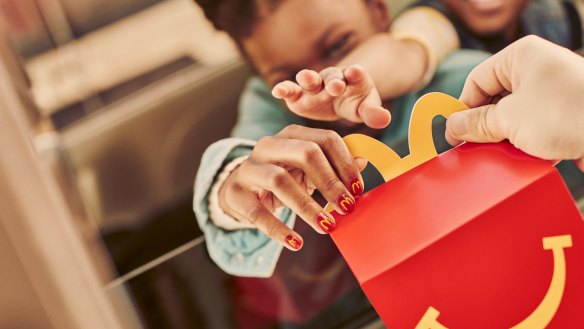
In the late 1970s, I went on a excursion with my class to the kitchen of a McDonald's in Rhode Island. We toured the grounds and learned how hamburgers were made, then assembled for a lunch of Happy Meals. That last part had been the promised centrepiece of the visit. Happy Meals were a big deal in the late '70s. Months earlier, when the Happy Meal debuted, I rode my bike to a McDonald's three kilometres from home. The commercials were all over Saturday morning TV. I needed an eraser shaped like Grimace. But my Happy Meal prize was always a top or a stencil.
So I got a lot of Happy Meals, and I got chubby.
Of course, turning children into regulars at McDonald's was the whole point. Joe Johnston, an Oklahoma author and artist, was a Cleveland adman in the early 1970s. "There was a sense [among McDonald's franchise owners] that kids didn't want to come to McDonald's. There was a feeling McDonald's was losing its connection to kids. There was no place to sit. Families took food to their cars. Kids were like, 'This sucks, I want crayons.' No one at McDonald's was addressing it."
He said the company gave him $700 to research ways to entice young families and his agency came up with a McDonald's "fun meal". It was essentially a sack with puzzles and activities on the packaging. No toys. "But toys, we learned, were key. Franchises were innovating. But they couldn't afford millions of toys."
Actually, many of the cultural items we associate with McDonald's didn't start at the company's headquarters (then in Oak Brook) but in local franchises around America.
Shamrock Shakes started in Connecticut.
Big Macs, in Pittsburgh.
Filet-O-Fish, in Cincinnati.
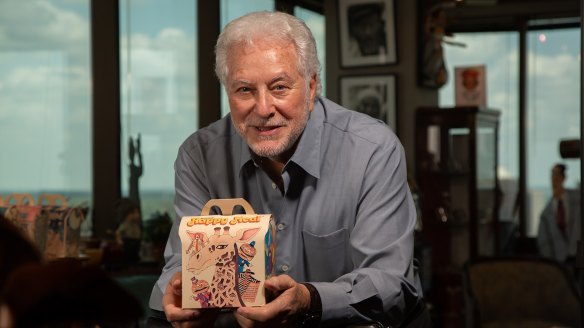
The toy takes hold
By the mid-'70s, the idea of a children's meal box (with a "prize") had been floating around the fast-food industry. Paul Schrage, a now-retired senior executive vice-president of McDonald's – he OK'd the Happy Meal to go national – says bluntly: "The idea [for the Happy Meal] came from our competitor, Burger Chef, which had been offering gifts to kids. Our regional ad manager in St. Louis, Dick Brams, was aware of this and thought it was a nifty idea and he contacted a guy in Kansas City named Bob Bernstein."
Of course, it's more complicated than that: Bernstein, whose advertising firm handled McDonald's restaurants in the US midwest and southwest (and still does), had already been working on a kids' meal. He said: "I came up with the Happy Meal, in 1975, as I watched my son at the breakfast table reading his cereal box. He did it every morning. I thought, we [could] make a box for McDonald's that holds a meal and gives kids things to do."
Boxes galore
At a meeting with franchise owners, Bernstein heard that mothers "needed something simple to handle" and restaurant owners wanted to streamline the often chaotic ordering of kids' food. So he began trademarking cups, plates, lids as "happy cups", "happy plates", etc. He made a deal to add cookies; he hired children's book illustrators and graphic designers to work on a box.
He wasn't the first.
As early as 1973, the Indianapolis-based Burger Chef had been offering its own Fun Meals that included a toy. (Burger Chef even had "Star Wars" boxes in 1978.) According to Meredith Williams, a Missouri collector of fast-food ephemera, individual McDonald's franchises around the country had tested similar concepts, from trick-or-treat packages and Mayor McCheese bags.
Still, Bernstein perfected the idea, Schrage said.
Before McDonald's agreed to make the Happy Meal a national product, Bernstein's Happy Meals were being tested and advertised for a couple of years in Kansas City, Phoenix and Denver. The ad executive even trademarked the Happy Meal name, then later transferred it to McDonald's for $US1 ($1.44). (He said he eventually received a $US5000 bonus for his creation.)
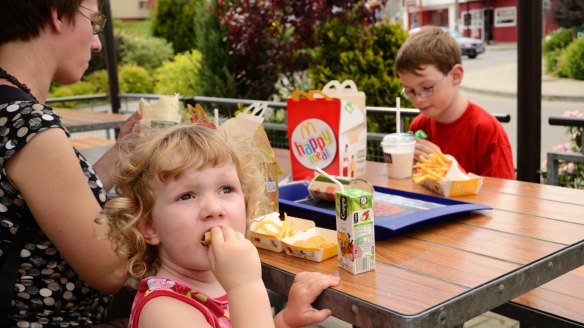
The Happy Meal is go
During the summer of 1979, McDonald's premiered the Happy Meal nationally. The first boxes were circus wagons. The first toys were tops, stencils, wallets, puzzles and erasers. And initially, meals included a hamburger or cheeseburger, fries, a soft drink and cookies.
So, there you go – Bob Bernstein of Kansas City, inventor of the Happy Meal.
He still keeps a bronze Happy Meal in his office, awarded by McDonald's in 1987 - the inscription thanks him for "for bringing the Happy Meal, a bold idea", to the company.
But then it gets weird.
When Dick Brams died at 45 in 1988, the former McDonald's employee, a popular figure in midwest advertising, was celebrated at his funeral as "father of the Happy Meal". Bernstein said it's here that the company started to say the Happy Meal was Brams' idea, "and that's just not true – Dick did a lot, but after the Happy Meal had already been created".
A 2009 touring exhibit of Happy Meal memorabilia, to mark its 30th anniversary, also identified Brams as "father of the Happy Meal". Today, if you Google "inventor of the Happy Meal", you are as likely to get Brams as Bernstein.
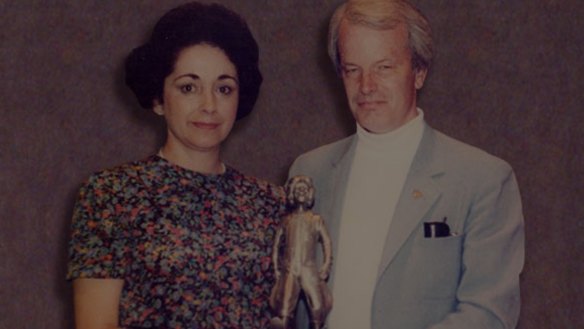
The Guatemalan connection
When I asked a McDonald's media contact who created the Happy Meal, the first name mentioned was Yolanda Fernandez.
She's 84, president of McDonald's Guatemala, and prefers to go by her husband's last name, Cofino. Jose Maria Cofino founded the first McDonald's in Guatemala in 1974 (he died in 1995), and in 1977, Yolanda created a "Ronald's menu" for the restaurant. It contained a hamburger, small fries, small Coke, small sundae. She added little toys that she bought at a local market. She packaged the whole thing on a tray – no box. "The thing is, nobody here in Guatemala really knew McDonald's when we started," she told me in a phone interview, "so they didn't know what a Big Mac was. And because they really didn't understand the name of the sandwiches, you would see a boy trying to finish a Big Mac. So I thought there should be a smaller meal, for a parent to order that a child could finish."
She said she never asked Oak Brook executives for permission to create Ronald's menu, but in 1977, at a McDonald's marketing conference in Chicago, she presented them with her idea. Bernstein said he began hearing only recently about Yolanda. He doesn't doubt her – again, the idea was in the air – but he insists he invented the Happy Meal as we know it.
The official line
As for McDonald's?
A media representative told me Yolanda "was the first to have this idea" of a value meal for kids. Indeed, in 1982, five years before Bernstein received his bronze Happy Meal for bringing the Happy Meal to fruition, the company gave Yolanda a silver Ronald McDonald statue, for developing the Happy Meal, as well as helping to grow the company's standing among children; they also credit her with developing the idea of McDonald's as a ready-made location for birthday parties. Like the creation of many cultural icons, when it comes to the invention of the Happy Meal, it appears there were a lot of cooks in the kitchen.
The rest you mostly know.
The Happy Meal became synonymous with suburban childhoods, as well as integrated, synergistic ecosystems of intellectual property tent poles spread across robust platforms.
But fun!
Rich Seidelman, of Illinois, worked as an art director on Happy Meal TV commercials for 22 years, mostly as an employee of the Leo Burnett advertising firm.
Because the first Happy Meals initially included "such chintzy toys", Seidelman said the advertising took pains to avoiding revealing "the prizes". But eventually Happy Meals became vehicles for showcasing cultural franchises, and the toys became more sophisticated.
Questions from the start
Controversies concerning the Happy Meal were apparent from the start. Just as the Happy Meal premiered nationally, Burger Chef sued McDonald's for ripping off its Fun Meals; later, McDonald's sued Burger King for ripping off Happy Meals to create Big Kids Meals.
Still, the majority of controversies centred on nutritional value. In 2010, a California class-action lawsuit claimed McDonald's used toys to unfairly entice children into eating unhealthy foods (the lawsuit was later dismissed); in 2002, New York teenagers sued McDonald's, claiming Happy Meals contributed to their obesity.
The story today
You can still find toys inside Happy Meals. And because McDonald's finally recognised a need to rework its nutritional standards, side options in Australia include apple slices and cherry tomatoes.
Christopher Bryan, an assistant professor of behavioral science at the University of Chicago – who recently co-authored a study to help kids avoid fast food – is not impressed. "I don't mean to suggest there are McDonald's executives laughing evilly somewhere trying to sell kids on poison, but that goodwill doesn't change what is harmful to kids. It's not even clear where blame lies now."
Ask those who contributed to the early days of the Happy Meal if they feel any guilt about the Happy Meal, and generally they say that fast-food nutrition was less of a concern in 1979.
Asked why the Happy Meal worked at all, Schrage, the retired McDonald's executive, said it was all about adding value: "You are getting not a toy, but a Disney toy, advertised on television, maybe connected to a movie. And it all adds value and makes that (Happy Meal) more important to a kid. And that's why it was successful."
Depending who answers, the Happy Meal was about competition.
Or finding new audiences.
Or exploiting kids.
But the lesson is, you can't make everyone happy.
Chicago Tribune
Restaurant reviews, news and the hottest openings served to your inbox.
Sign up- More:
- Restaurant news